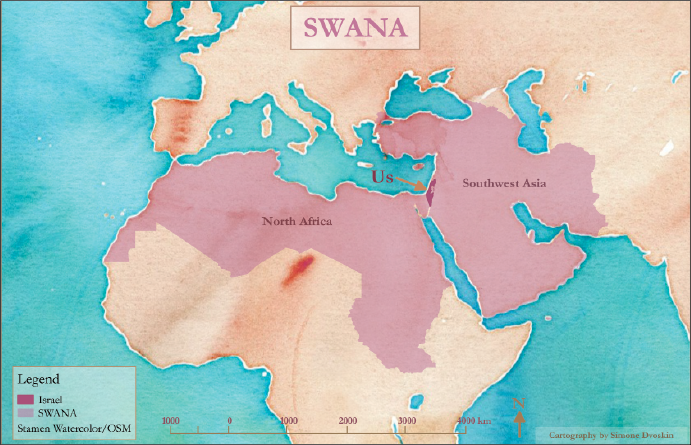Cartography by Simone Dvoskin
_________________
A new paradigm has been gradually emerging at UCLA. Iranian students, Armenian students, students from Arab countries and others are coming together to create a new, broader identity. SWANA, which stands for Southwest Asia and North Africa, encompasses a broad range of ethnic and national groups from the region, uniting them based on shared historical and personal experiences.
Where are the Jews?
At the 2012 UC-wide Students of Color Conference, students who identified as SWANA first came together, with the goal of changing the UC application. They felt that being forced to identify as “Caucasian” on the UC application misrepresented their identity. A year later, a USAC resolution at UCLA called for the UC application to recognize the SWANA identity, creating a separate checkbox that people who identify as SWANA could check off. Admitted students who do so would then be able to select a subcategory of the SWANA identity with which they identify. There are a total of 34 options, including some linked primarily to ethnicity like “Kurdish” and “Berber” and others linked primarily to nationality like “Moroccan” and “Israeli.” Unfortunately, “Jewish” is not an option.
The UC regents approved this policy, and this past year a SWANA option was implemented on the UC application. This was a significant victory for most SWANA communities on this campus — but it did nothing to help most Jews.
Most Jewish students at UCLA do not identify as Israeli, as most of us are not from the modern state of Israel. However, all of us originate from Judea, a geographical region in Southwest Asia that should be included in the SWANA paradigm. Nonetheless, Jews who don’t identify as “Israeli” have no box to check on the UC application.
Admittedly, there have been points in our history when we were presented as a religious community with no ethnic component. In Europe between the French Revolution and the Holocaust, Ashkenazi Jews (including my ancestors) were expected to define themselves as natives of the countries in which they lived in order to be granted civil rights in those countries. This policy was famously articulated by Count Claremont-Tonerre before the French National Assembly in 1789, when he declared: “We must refuse everything to the Jews as a nation and accord everything to the Jews as individuals… It is repugnant to have in the state an association of non-citizens, and a nation within a nation.” However, in the years following the Holocaust, our ethnic identity has reemerged, and we once again feel safe expressing our non-European origins.
As an Ashkenazi Jew, I have never identified as “Caucasian.” My grandparents living in Poland were Jewish, not Polish, as their Polish neighbors would have been happy to attest. Being forced to check the “Caucasian” box on my UC application was an unpleasant experience for me. The university that I was hoping to attend had formalized my identity in a way that was foreign to me, and I had no way to correct them.
Unfortunately, no efforts that I’m aware of were made by Jewish students to gain inclusion in the effort to change the UC application. As a result, our status as a Southwest Asian ethnic group was not recognized by the University of California.
Late is better than never, however. The UCLA Jewish community should reach out and participate in other efforts that encompass the SWANA identity. For example, SWANA communities will be coming together this coming Fall quarter to create a retention program to reduce dropout rates in their communities. Jewish students who are at risk of dropping out should take advantage of this resource, and other Jewish students should volunteer their time to help other Southwest Asian and North African students remain at UCLA. In addition, interested students are encouraged to contact the author to find other opportunities to get involved.

